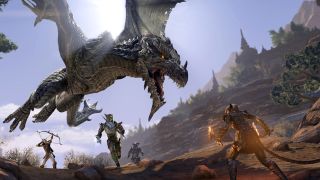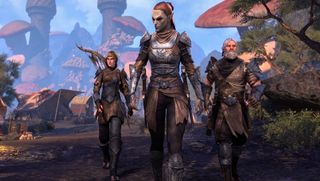The Elder Scrolls Online has made nearly $2 billion in its lifetime, 9 years after the big comeback that doubled its player count overnight
After 10 years, TESO is an even bigger financial success than I realized.

The Elder Scrolls Online doesn't always get the credit it's due for being a genuinely good MMO that's been putting out regular expansions and new storylines for a decade. Even though I mained it for a few years myself, I'm guilty of sometimes overlooking it in the shadow of Skyrim's eternal relevance and flashier MMOs. But the numbers win out, as Zenimax Online Studios director Matt Firor revealed during a talk at the Game Developers Conference this year. Over its lifetime, TESO has made nearly $2 billion and has no plans to stop expanding its world and story.
In his GDC talk, 10 Years In Tamriel: Success of The Elder Scrolls Online, Firor started with TESO's conception, when it was originally pitched as The Elder Scrolls: Origins. Its inspirations were drawn from World of Warcraft—in the era when so many MMOs were envisioned as WoW-killers—Firor's past work on Dark Age of Camelot, and the then-popular Elder Scrolls IV: Oblivion.

The TESO team had been working for several years already on that vision before Skyrim swooped in and set fire to their plans by resetting player expectations for an Elder Scrolls game. Skyrim had fully voiced characters, first-person view, and no minimap—all things that influenced the new direction for what was renamed The Elder Scrolls Online. Handy that they got to keep the acronym, at least.
Despite that effort to step up and meet the new standard Skyrim set, TESO's launch wasn't a pretty one. At the time, we weren't impressed either. "We got a lot of feedback," Firor said during GDC, putting it diplomatically. It was an unfortunate storm of bugs, lack of a player economy, combat critique, and dissatisfaction with the required subscription, Firor enumerated.
A year later, after a lot of work, TESO had a comeback story not unlike that of Final Fantasy 14's well-known A Realm Reborn pivot, in which it rebranded with Tamriel Unlimited in 2015. That update brought guild traders, a more sandbox-y justice system in typical Scrolls style, and made the subscription optional.
Do you really care what level you are in GTA or other modern games? No, you just log in and play and have fun. We wanted to make ESO that kind of game.
Matt Firor, ZOS director
"Overnight on PC our login population doubled just because players could come back without subscribing, they could just play," Firor said. "The night after that it doubled again. So we knew we were on the right track." He says that TESO welcomed three million new players in just two months and hit 500,000 concurrent players across all platforms at that point.

Firor credits the real long-term success of TESO to the Tamriel Unlimited update a year later in 2016, which allowed players of the three main factions to play together and, more importantly, introduced level-scaling to the entire game so that any player could play any zone and story they wanted. "Do you really care what level you are in GTA or other modern games? No, you just log in and play and have fun. We wanted to make ESO that kind of game." At that point, Firor said it became "like a true heir to Skyrim."
The biggest gaming news, reviews and hardware deals
Keep up to date with the most important stories and the best deals, as picked by the PC Gamer team.
He described the trajectory of ESO at that point as a healthy MMO with a growing population in which returning players never felt left behind. As someone who's dropped in and out over the years I can confirm that it is one of the best at not making me feel like a dunce every time I come back. I found starting FF14 to be daunting (in part due to the subscription, Firor's right on that point) and every time I go back to my old Guild Wars 2 haunts I feel like I'm just too out of touch.
But logging into ESO I pretty much know I'm only five steps away from some great, classic Elder Scrolls side story. One of my best memories of the game was when I returned to play an expansion after a break and realized over the course of a comedic sidequest to locate a concerned woman's flighty son that I was about to see a cameo from one of the main questline characters. I often find myself checking out from the overarching lore in other MMOs but not in ESO. My buddy Razum-dar making an appearance? I love Raz!

Firor clearly knows that storytelling is one of TESO's strengths. After those two pivotal years of game updates, TESO adopted a yearly story update cadence that it's maintained since. Each expansion, which it calls a "chapter," is a sort of yearly four course meal that involves an overarching story, a new explorable zone, a paid expansion, and a smaller DLC.
And now, Firor revealed, it's earned almost $2 billion over its full lifetime. Firor didn't break down that figure into DLC versus cash shop versus optional subscriptions, but it's a damn big number. Developers aren't often so transparent with sales figures and player numbers, but a decade after its inauspicious launch feels like a good time to celebrate.
After years of steady expansions, ESO has retained a pretty healthy player population—nearly 30,000 concurrent players on Steam alone right now, according to Steam.db. It's been the location of some excellent player stories like its incredibly impressive house builders and my favorite local celebrity Sleeps-On-Bridges. We still consider it one of the best MMOs on PC.

Lauren has been writing for PC Gamer since she went hunting for the cryptid Dark Souls fashion police in 2017. She accepted her role as Associate Editor in 2021, now serving as self-appointed chief cozy games and farmlife sim enjoyer. Her career originally began in game development and she remains fascinated by how games tick in the modding and speedrunning scenes. She likes long fantasy books, longer RPGs, can't stop playing co-op survival crafting games, and has spent a number of hours she refuses to count building houses in The Sims games for over 20 years.
Most Popular






